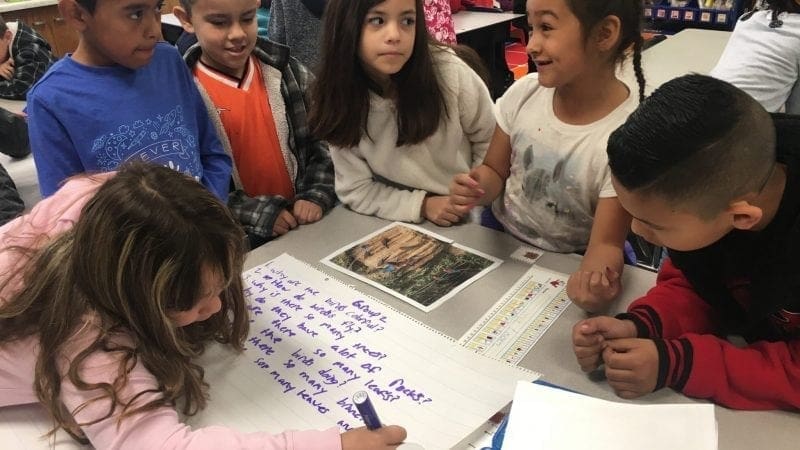A Shift That Just Makes Sense
When students ask their own questions, it sparks curiosity, independence, and self-confidence, cultivating students’ ownership over their own learning. This is a shift that just makes sense. So how does an instructional coach, like myself, create this shift and promote curious conversations in the classroom?
At our school, asking and answering questions is an essential standard for all grades and there is a need to promote conversations between students, especially our English Learners population. At the end of the 2017 school year our team of administrators and Site Instructional Coaches went on what we call “instructional rounds,” we gathered data on what we observed in classrooms, noted the types of questions students were being asked, the opportunities for students to ask their own questions and how engaged students were in conversations. In most cases, we found that teachers were asking most of the questions and, at times, even answering their own questions. We needed to find a way to not only engage students in productive conversations, but also equip students with skills to form a variety of questions in this discourse. We needed a shift.
Based on data gathered about student learning from our Instructional Rounds, the team found that more than 50% of our students were minimally engaged in the learning process. Our teachers are working diligently to increase student engagement through collaborative conversations and critical thinking. QFT is helping us to address both of these areas.
– Cynthia Coello, Zimmerman Elementary Principal
How the QFT Became A Solution at Colton Unified School District (CUSD)
CUSD: District Collaboration
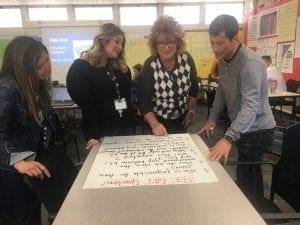 When district personnel and I collaborated at the Question Formulation Technique professional development workshop in California, it sparked conversation about how the QFT could simultaneously be productive at elementary, middle and high school classrooms and provide Professional Learning for Educators (PLE). Instructional coaches went back to their sites at the elementary, middle and high school levels, and began to introduce teachers to this new powerful tool for students asking questions. The district personnel immediately implemented the QFT when they facilitated Instructional Leadership Team (ILT) meetings at different school sites, using school data as the QFocus. Because ILT teachers at other school sites marveled at this technique and integrated it into their classrooms, our ILT at Zimmerman Elementary felt validated and supported in using the QFT. Additionally, it was effective to have alignment within the district; there was a collaborative effort in using the QFT for discourse, not just at the student level but also for professional learning at the district level.
When district personnel and I collaborated at the Question Formulation Technique professional development workshop in California, it sparked conversation about how the QFT could simultaneously be productive at elementary, middle and high school classrooms and provide Professional Learning for Educators (PLE). Instructional coaches went back to their sites at the elementary, middle and high school levels, and began to introduce teachers to this new powerful tool for students asking questions. The district personnel immediately implemented the QFT when they facilitated Instructional Leadership Team (ILT) meetings at different school sites, using school data as the QFocus. Because ILT teachers at other school sites marveled at this technique and integrated it into their classrooms, our ILT at Zimmerman Elementary felt validated and supported in using the QFT. Additionally, it was effective to have alignment within the district; there was a collaborative effort in using the QFT for discourse, not just at the student level but also for professional learning at the district level.
Zimmerman Elementary: A Schoolwide Approach
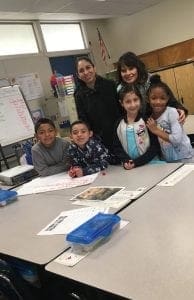
As this work was happening around the district, I set out to bring the QFT back to my colleagues at Zimmerman Elementary school. To introduce the strategy, I collaborated one on one with the first five teachers interested in learning the QFT. My principal was very supportive and allowed me to schedule an all day substitute teacher to cover classrooms while we collaborated.
We began our meetings with having each teacher become a member of the Educator Network on the Right Question Institute website so they can be exposed to the forums and resources available. Each teacher designed their lesson using a standard PowerPoint, but then adapted it for their individual objectives and content areas. Some used Google Slides for students to type their questions and some chose to use Flip Grid to record their student’s reflections. After planning the QFT, I modeled the first lesson using a co-teaching structure. After each lesson, the teacher and I debriefed on what went well and what needed some fine tuning. This setup allowed teachers to observe the QFT in action without having to simultaneously worry about implementing it. Teachers saw that the QFT gave students an opportunity to think for themselves and collaborate. Previously, teachers had noticed that students were trapped in their own way of thinking but through the QFT process, students were able to listen to others ask questions and hear different perspectives.
The QFT process is helping my students to become more aware of the skills needed to ask the right questions when analyzing a topic. I’m beginning to see an increase in my students abilities to ask open-ended questions. These types of questions are great for group discussions as they require explanation and elaboration.
– Fred Aiello, Fifth Grade
QFT impacts my teaching because it allows me to see where my students may have gaps in their understanding or learning. Using QFT allows me to see where to focus my lessons and allows me to get a grasp of the students knowledge to see what they need to understand better.
– Celia Salazar, Third Grade
Teacher Buy In
All people have a tendency to grapple with change. To me, one of the key levers in implementing a school wide change like this is empowering teachers by inviting them to be a part of the PLE and present as a team. That’s how we approached the professional learning about the QFT.
Three of the pioneer teachers who had implemented the QFT and were from different grade levels hosted a forum for teachers to ask questions about the successes and challenges of the QFT. I showed videos of our own students at Zimmerman engaging with the QFT so other teachers can see what the QFT accomplishes with our students in our classrooms. During this PLE, teachers also went through the QFT process, so they themselves could experience what the students experience. All of the above were intentional measures taken to help teachers feel comfortable with this change. After the PLE, I emailed teachers for feedback on how they perceived this technique would benefit their students and provided support for teachers who expressed interest in implementing the QFT. By identifying some QFT cheerleaders, we were able to create excitement amongst grade-level teams about this technique and helped spread it throughout the campus.
I made the decision to share QFT with my grade level because of the impact it had on my teaching and students. I felt if I relayed this message to other teachers it would empower them to recognize the importance of students asking questions. Informing more teachers about QFT will create more classrooms where students are having conversations that include questioning instead of us always asking questions.
– Delia Schornack, Second Grade
Challenges in Implementing the QFT
- Scaffolds and Modifications
As a “trial” run, I focused on the entire kindergarten team to use the technique as a starting point for students to become familiar with the process. Initially, kindergarteners were giving statements, not asking questions. We discovered that the QFT required some adaptations for the younger grade levels. We used various scaffolds like providing kindergarteners with question starters, “Who, what, where, when, why_____?” Within a few uses of the QFT, we saw a difference in students’ language in posing questions. Furthermore, we observed an improvement in the quality of their questions. Through consistency, we recognized an evolution in their question asking abilities and noticed the nuances in their questions.
One thing I have noticed in my students is that they are now looking deeper at the whole picture in general to formulate their questions and not just stating the obvious questions. They are looking deeper and trying to come up with more detailed questions.
– Sandra Harworth, Kindergarten
A second challenge teachers noticed were students having difficulty in categorizing and converting open- and closed-ended questions. We decided that students needed an introduction to these types of questions before implementing a QFT lesson. Through a collaborative effort to problem solve, one teacher created a PowerPoint to instruct students on these types of questions and incorporated games to excite students. This PowerPoint was then shared with other teachers as a pre-lesson before the initial QFT lesson. Students began to make interesting observations. Students noticed, in most cases, if they deleted the first question word in an open-ended question it could become a closed-ended question. Teachers noticed a substantial change with not just the decrease in time in regarding open and closed identification and conversion, but their students had mastered open and closed questions and set the students and teachers on this trajectory to move forward with curiosity empowerment.
Differentiating between open and closed questions was a bit of a challenge at first. I created PowerPoints to have them practice. Not only did they love practicing, but it made the QFT process easier for them. I loved seeing them collaborate with their groups and put a lot of effort into their questions. My students learned the importance of asking questions and how it can be applied in different subject areas.
– Delia Schornack, Second Grade
- A Waste of Time?
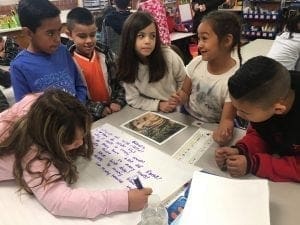 Teachers had concerns that the QFT took time away from their daily routine. I reminded them like with anything else, with consistency and practice, time will actually be saved because they will notice their teaching will become more focused based on students’ questions. Teachers will not be spending a lot of time teaching what students already know, but what they are interested in learning. It can also simultaneously help teachers understand what students are thinking and easily align to standards. Consequently, using the QFT is a tangible way of engaging in the school’s focal point and mission of prioritizing students asking questions.
Teachers had concerns that the QFT took time away from their daily routine. I reminded them like with anything else, with consistency and practice, time will actually be saved because they will notice their teaching will become more focused based on students’ questions. Teachers will not be spending a lot of time teaching what students already know, but what they are interested in learning. It can also simultaneously help teachers understand what students are thinking and easily align to standards. Consequently, using the QFT is a tangible way of engaging in the school’s focal point and mission of prioritizing students asking questions.
The critical thinking the students are doing and the questions they are producing definitely outweigh the time it takes to set up this process in your classroom.
– Mayra Ibarra, Sixth Grade Teacher
Consistency Through Continued Support
As an instructional coach it is my role to support instruction. However, the best support I can provide teachers is to allow them to be a part of the decision making and the learning. One reason I liked using the QFT in the PLE is it helped me to accomplish that. Fostering conversations filled with curiosity is now happening not only between our students but also between teachers and instructional coaches.
Author Bio
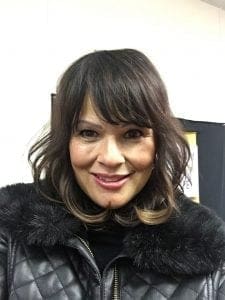 Monique Almendarez is an instructional coach at Zimmerman Elementary in California. She provides instructional delivery assistance and support to teachers including co-planning, co-teaching, and demonstrating lessons. She also meets with teachers on a regular basis to select, diagnose, instruct, assess, and monitor students. Monique also provides Professional Learning Experiences as well as facilitates school-wide events.
Monique Almendarez is an instructional coach at Zimmerman Elementary in California. She provides instructional delivery assistance and support to teachers including co-planning, co-teaching, and demonstrating lessons. She also meets with teachers on a regular basis to select, diagnose, instruct, assess, and monitor students. Monique also provides Professional Learning Experiences as well as facilitates school-wide events.
